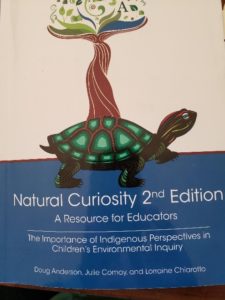by Wendy Warren

What questions did your family ask last week, as you went out and explored the natural world? How did you go about finding answers—and then going even deeper into the topic? As last week’s blog post shared, following your natural curiosity leads to some of the most authentic learning there is. Sometimes it takes a spark to rekindle curiosity that lives right at the surface of most children, but sometimes gets buried deep inside later in life.
 Natural Curiosity 2nd Edition: The Importance of Indigenous Perspectives in Children’s Environmental Inquiry shares the benefits and importance of inquiry-based learning. The following is a condensed version from authors Doug Anderson, Julie Comay, and Lorraine Chiarotto. They write:
Natural Curiosity 2nd Edition: The Importance of Indigenous Perspectives in Children’s Environmental Inquiry shares the benefits and importance of inquiry-based learning. The following is a condensed version from authors Doug Anderson, Julie Comay, and Lorraine Chiarotto. They write:
1.Honouring interests and questions related to a common focus or big idea leads to higher levels of engagement, improved understanding, and a love of learning.
2.Inquiry stimulates and focuses students’ curiosity, leading to progressively deeper questions and a habit of critical thinking. By fostering a culture of inquiry, educators help students become more discerning observers, deeper thinkers, and more innovative problem-solvers.
3.Inquiry builds lifelong learning skills that go beyond content mastery.
4.Engaging in inquiry encourages perspective-taking, collaborative problem solving, and communal knowledge building.
With everyone working from home, families now have a unique opportunity to create a learning community in your own homes. Breakfast, dinner, or bedtime conversations might include something new each person noticed, or a time for sharing something new each person learned that day or at some point during the week. Often, these conversations raise new questions in everyone’s minds—setting the stage for another round of inquiry-based learning. You know you’re doing something right, if you end up with more questions than answers at the end of a conversation. Such is the nature of inquiry.


0 Comments